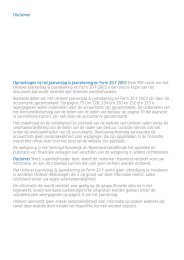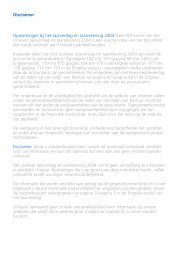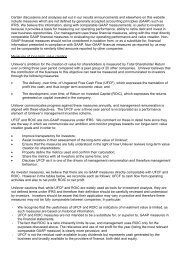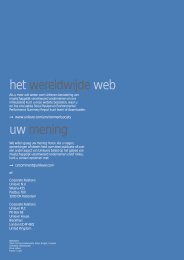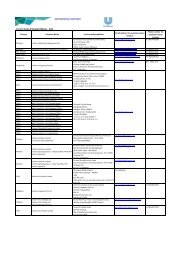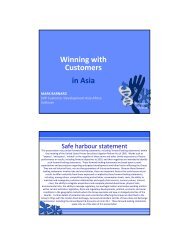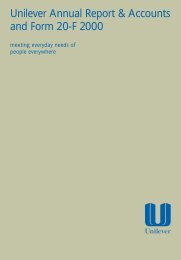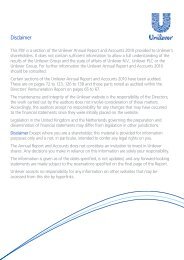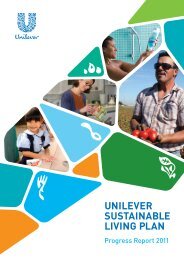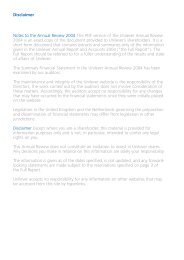Meeting everyday needs of people everywhere - Unilever
Meeting everyday needs of people everywhere - Unilever
Meeting everyday needs of people everywhere - Unilever
You also want an ePaper? Increase the reach of your titles
YUMPU automatically turns print PDFs into web optimized ePapers that Google loves.
13 <strong>Unilever</strong> Annual Report on Form 20-F 1999 Report <strong>of</strong> the Directors<br />
Performance review<br />
This discussion, unless otherwise indicated, is based on<br />
the results <strong>of</strong> our Group’s continuing operations, which:<br />
•<br />
•<br />
includes acquisitions made each year;<br />
excludes from 1997 the speciality chemicals<br />
businesses that were sold in 1997 and the proceeds<br />
<strong>of</strong> that sale.<br />
Our accounting policies are based on United Kingdom<br />
generally accepted accounting principles (GAAP) and<br />
Dutch GAAP which differ significantly from United States<br />
G A A P. The principal diff e rences are described on page 1 0 7 .<br />
We have shown reconciliations to the approximate net<br />
income and capital and reserves under US GAAP on<br />
page 106.<br />
Euro reporting<br />
Following the introduction <strong>of</strong> the euro, we have<br />
published supplementary information in euros<br />
throughout 1999 and will replace the guilder and<br />
sterling with the euro for reporting purposes from the<br />
start <strong>of</strong> the year 2000.<br />
Effect <strong>of</strong> exchange rates on the way we<br />
present our financial statements<br />
We have published our accounts in two currencies,<br />
Dutch guilders and pounds sterling. The effect <strong>of</strong><br />
exchange rate fluctuations over time may result in<br />
the trends shown in the guilder accounts differing<br />
significantly from those shown in the sterling accounts.<br />
Foreign currency amounts are translated into the<br />
published currency using annual average exchange rates<br />
for results and cash flows. An exception to this was in<br />
1997, when the pr<strong>of</strong>it on disposal <strong>of</strong> the speciality<br />
chemicals businesses was translated at the rates<br />
prevailing on 8 July 1997, and the discontinued<br />
businesses’ results were translated at the average rates<br />
up to the date <strong>of</strong> disposal. Year-end exchange rates are<br />
used for the consolidated balance sheet, except for the<br />
ordinary capital <strong>of</strong> NV which is translated at the rate<br />
<strong>of</strong> £1 = Fl. 12 (see Control <strong>of</strong> <strong>Unilever</strong> on page 118).<br />
The exchange rates used for the last five years were:<br />
Fl. 1 to £1<br />
0005111<br />
Average rates Year-end rates<br />
00001105111 05111<br />
1995 Fl. 2.53 Fl. 2.49<br />
1996 Fl. 2.62 Fl. 2.96<br />
1997 Fl. 3.18 Fl. 3.34<br />
1998 Fl. 3.29 Fl. 3.12<br />
1999 Fl. 3.35 Fl. 3.55<br />
In the following discussion we have used annual average<br />
exchange rates to translate foreign currency amounts.<br />
To eliminate the effect <strong>of</strong> exchange rate fluctuations,<br />
we express our key year-on-year comparisons at<br />
constant rates <strong>of</strong> exchange. This means using the<br />
annual average rates for the previous year so that<br />
year-on-year comparisons are the same in both guilders<br />
and sterling.<br />
Our results in a particular reporting currency (guilders or<br />
sterling) are depressed in years in which the reporting<br />
currency strengthens in relation to other currencies and<br />
vice versa. The difference between the percentage<br />
change calculated for each <strong>of</strong> the reporting currencies in<br />
the table below and the percentage change at constant<br />
exchange rates reflects the extent to which the reporting<br />
currency has strengthened or weakened against the<br />
weighted average <strong>of</strong> the underlying currencies. The<br />
difference in the percentage change between the guilder<br />
accounts and the sterling accounts reflects the<br />
movement in the exchange rate between the two<br />
currencies. Figures in 1996/1997 and the trend in<br />
1997/1998 are impacted by the pr<strong>of</strong>it on disposal<br />
<strong>of</strong> the speciality chemicals businesses.<br />
The following table shows certain percentage increases/(decreases) in our Group results between years expressed in<br />
guilders and sterling, and at constant exchange rates.<br />
00000000000110000011<br />
1996-1997 1997-1998 1998-1999<br />
0000 0000 0000<br />
Results Const. Results Const. Results Const.<br />
Fl. £ Rates Fl. £ Rates Fl. £ Rates<br />
% % % % % % % % %<br />
0000011 1011 1011 011 1011 1011 011 1011 1011<br />
Turnover 8 (11) (1) (6) (9) (2) 1 — 2<br />
Operating pr<strong>of</strong>it 1 (17) (8) 28 24 34 (2) (4) (2)<br />
Net pr<strong>of</strong>it 159 107 141 (41) (41) (38) (6) (7) (5)<br />
00000000000110000011



